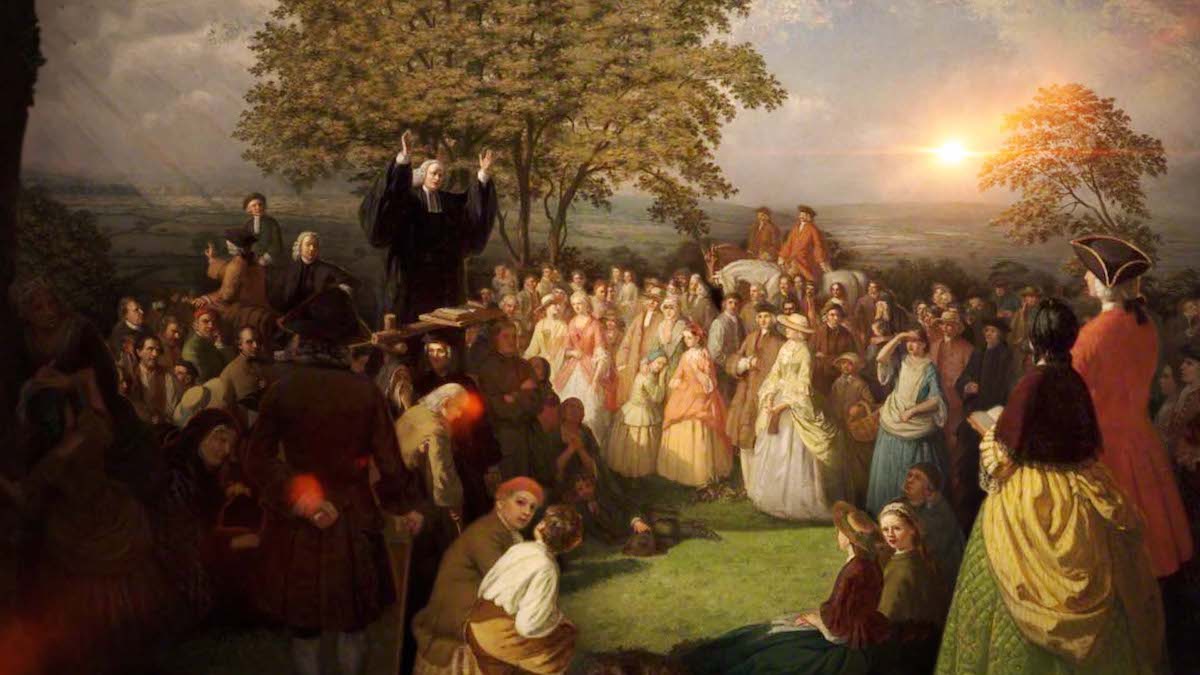George Whitefield’s first sermon after his ordination, in June 1736, prompted a complaint to the bishop! He later printed the sermon with the title On the Nature and Necessity of Our Regeneration or New Birth. Whitefield was never far from controversy, both with the established church (in England and American) and, sadly, the great John Wesley. Whitefield was a central figure in the evangelical revival of the 18th century and proved absolutely scathing about the condition of pre-revival clergy. Perhaps less organizationally gifted than Wesley, he nevertheless brought the Gospel to both the poorest of British workers as well as the English aristocracy (forming a close bond with the Countess of Huntingdon, whom we will meet later in the series), thus proving to be an extremely influential figure in the development and continuation of the evangelical tradition within the Church of England.
George Whitefield (1714–1770) was born on December 16, 1714, at the Bell Inn, in Gloucester, England. He was the youngest of seven children to Thomas and Elizabeth. His father died when he was just two years old, his mother made an unsuitable remarriage, and the prosperity of the inn declined rapidly. We know the details of Whitefield’s early life from his Journals, including his “A Short Account of God’s Dealings with the Reverend Mr George Whitefield,” although they cover the period only up to 1745 and have the benefit of hindsight.
Just before his 18th birthday, George entered Oxford as a “servitor.” This was the poor man’s way into Oxford. The student was granted free tuition, but the servitor had to serve other students, wear distinctive dress, and was not permitted to receive Holy Communion with the other students. However, it opened the door to a better, and higher, life.
George Whitefield was prime material for the Holy Club, formed at Oxford by, among others, Church of England priest and evangelist John Wesley and his brother Charles. Club members agreed to take Holy Communion every week, fast regularly, and follow the festivals of the church, as well as visit prisoners in jail. Like Wesley, Whitefield constantly experienced the inner conflict and struggle of daily temptation and the desire to live a religious life. Before arriving at Oxford, he was already reading William Law’s A Serious Call to a Devout and Holy Life. Soon after his arrival he noted in his Journal that “I now began to pray and sing psalms thrice every day.” Whitefield also recorded his admiration for the “Methodists,” those who were “methodical” and disciplined in their personal piety. It was perhaps inevitable that he join them.
Whitefield’s inner struggles continued. He sought counsel from the Wesleys and, after a breakfast with Charles, was recommended Henry Scougal’s The Life of God in the Soul of Man. Scougal was a 17th-century Scottish theologian and minister, and his book was instrumental in turning over Whitefield’s way of thinking. The Life of God, he recounted, introduced him to true religion as union with Christ rather than the discharge of duty. His moment of conversion was near, which he described in his Journal to have occurred around seven weeks after Easter 1735: “I was delivered from the burden that had so heavily oppressed me,” an expression that reflected the classic evangelical conversion narrative.
Whitefield sought ordination—we have already noted the impact of the first sermon—and then, quite possibly under Wesley’s influence, headed for the state of Georgia in early 1738. The American colonies held some fascination for these early revival leaders. The colony of Georgia had been founded in 1732, with Savannah as the main settlement from 1733. Both Wesley and Whitefield and, indeed, others were drawn here owing to the possibility of the conversion of the indigenous population as well as the opportunity to minister to the settlers. What soon became clear was that the impact of disease left many children orphaned, and raising support for a Savannah orphanage became a focal point of ministry in the Americas for Wesley and Whitefield. In his early visits to the state, Whitefield was shocked by the brutality of slavery. Yet, as a property owner and defender of property rights, he soon warmed to the idea, referring to the need for slave labor to expand his property. He even offered his profuse thanks to benefactors who purchased property and slaves for him in South Carolina. Wesley never went down this road, abhorring slavery, and yet it is the case that many first-generation evangelicals either endorsed or simply accepted slavery. Atonement and abolitionist action would come half a century later.
Yet slavery was not the only source of division between the great Anglican evangelists, or between them and many of their fellow clerics in the Church of England. The preaching of the new birth that lay at the heart of the revival ministry was, essentially, divisive. Many in the Established Church believed it called into question the state of their own souls if they had not experienced some special inner revelation or conviction of sin. In these early years Whitefield found himself frequently refused pulpits and embroiled in controversy. As a result he preached more often than not to religious societies, in prisons, and, increasingly in the open air. Whitefield was especially drawn to the plight of the poor miners in the Kingswood district of Bristol, whom he described as sheep without shepherds. In recounting his first venture into preaching in the open fields, with some 200 in attendance, he wrote that some “may censure me; but if I thus pleased men, I should not be the servant of Christ” (Journal, February 1739). It was a momentous turning point. Within a month Whitefield was preaching to 10,000 at Kingswood, writing in his Journal that the “fire is kindled in the country; and, I know, all the devils in hell shall not be able to quench it” (February 25, 1739). In April, he preached to an estimated 30,000 at Kennington in London.
Whitefield was soon also causing disruption on his visits to America in 1738 and 1740. He upset the clergy of the established church by referring to the Philadelphian Presbyterian Gilbert Tennant as a faithful minister of Jesus Christ, preaching in Presbyterian churches and Congregationalist chapels, and receiving Holy Communion from a Baptist minister. He preached some 200 sermons across New England, New York, and Philadelphia, as well as the Carolinas. On one occasion he preached outdoors to 23,000 in Boston. Mostly it was the ministers of the established church that excluded Whitefield.
For a movement that proclaimed new birth and personal transformation, the turmoil and infighting that seemed inevitably to follow in its wake was damaging. Built as the movement was upon individual salvation, strong-willed personalities, innovation, and the challenging of established ecclesiastical boundaries, this outcome is, perhaps, not surprising. The theological dispute that split the John Wesley and Whitefield, however, was particularly acute, vicious, and painful.
A sermon by Wesley entitled “Free Grace,” which he preached with little controversy in 1739 and then published in 1740, was the catalyst for the dispute. The key point of debate was the nature of divine election and eternal destiny. In other words, the argument concerned the extent to which the individual was chosen by God for eternal salvation or eternal damnation. Did God select, or elect, individuals for salvation or damnation from the beginning (Whitefield) or did people have the free will to respond to the Gospel message (Wesley), and so were alone responsible for their fate? This led to further questions around whether Christ died for all humankind or only the elect, the efficacy of preaching, and the dangers of the perception that living a disciplined, holy life was not necessary if God had predetermined one’s salvation or damnation.
Whitefield had urged Wesley not to enter into controversies or disputes. Wesley’s printer initially refused to print “Free Grace.” Whitefield headed back to America, but the controversy and correspondence continued. The distance didn’t help and several letters crossed in the post. In one, dated March 26, 1740, Whitefield wrote that “I am ten thousand times more convinced of [the doctrine of election], if possible, than when I saw you last.” The prospects for reconciliation were fading.
When Whitefield returned to England in March 1741, Wesley resolved to see him. The outcome was not pretty, Wesley, in his Journal, noted that Whitefield had told him that “he and I preached two different gospels” and, as well as denying the hand of fellowship, “was resolved publicly to preach against me and my brother.”
How far these evangelicals had come, and in so short a time. There were attempts at reconciliation in subsequent years, concessions, correspondence, occasional meetings, preaching for each other and on occasion together. Despite their strong theological differences, which it should be noted continue to this day among evangelicals of all stripes, Whitefield claimed he would not see Wesley in heaven because Wesley would be so near to the throne. In his will, Whitefield requested that Wesley preach the funeral sermon. (In fact, Wesley preached a memorial sermon in London, Whitefield dying in the American colonies.)
Whitefield represented a moderate Calvinism, much in line with the Reformation-era Thirty-Nine Articles of the Church of England. He used gesture extensively in his sermons, leading one biographer to call him the “divine dramatist.” He was a man of firm conviction and viewed the proclamation of the Gospel as a priority that overruled the norms and conventions of church life at the time. He died too young, at the age of 55. He crossed the Atlantic some 13 times and his influence was extensive in both England and the colonies (where he developed a friendship with none other than the “worldly” Benjamin Franklin, an admirer of Whitefield’s oratory and publisher of several of his tracts). His early death meant that he had no real opportunity to form and shape an organization to continue the more Calvinist part of the revival. Yet the power of his preaching to thousands, his proclamation of the new birth, his doctrinal depth and clarity, and his passion for the poor should leave us thankful to God for calling him—one of the defining and foundational leaders of the fires of evangelical Christian revival.
The is the third installment in a series on the British evangelical revival. Revisit Part 1 and Part 2.

